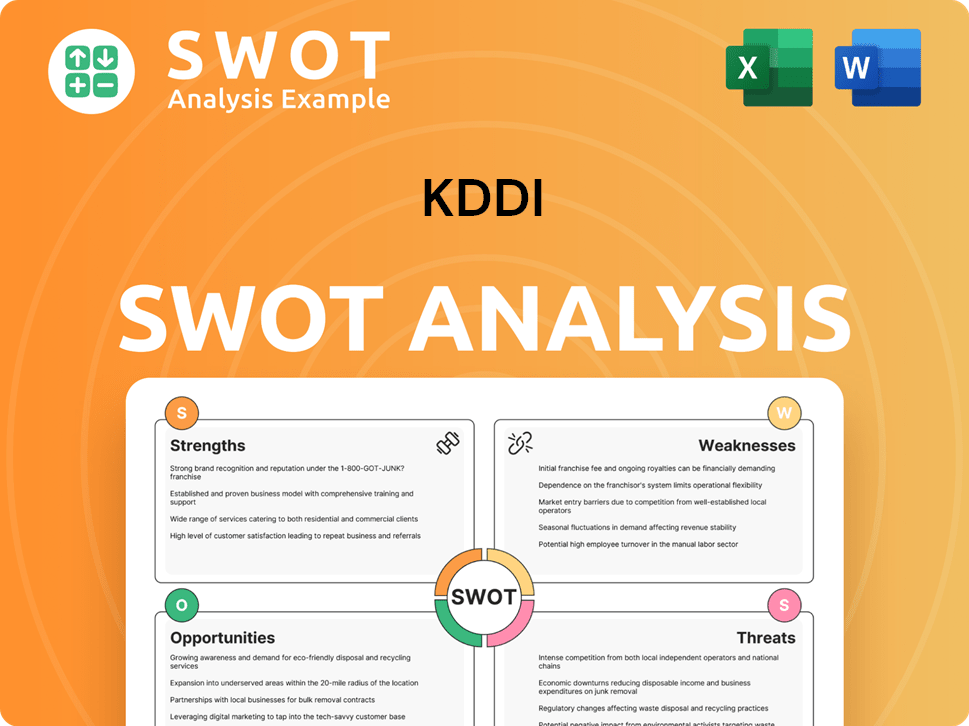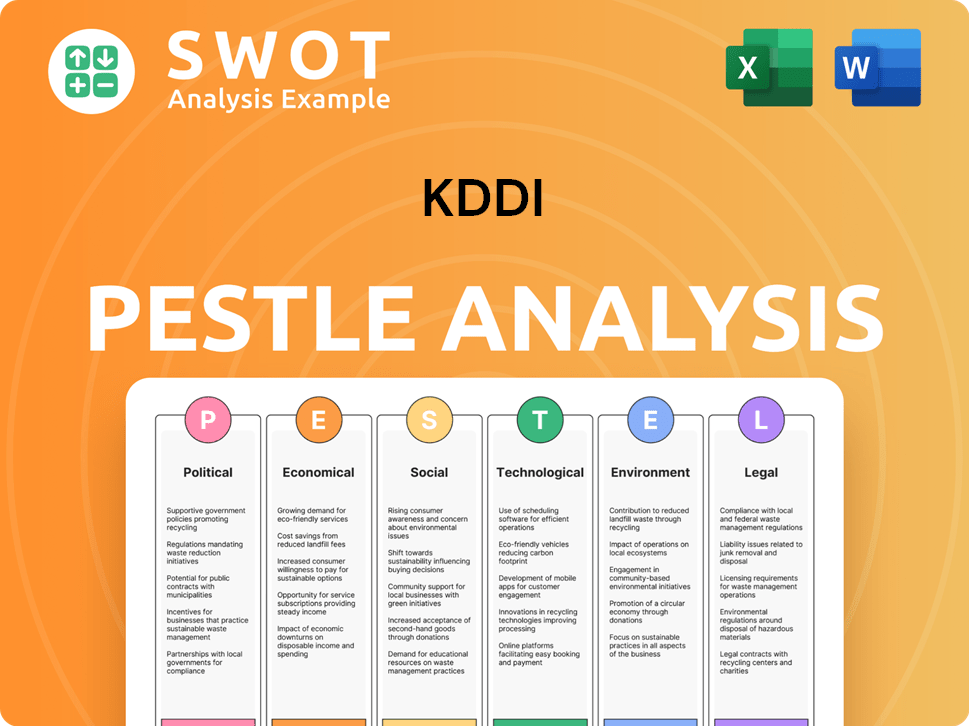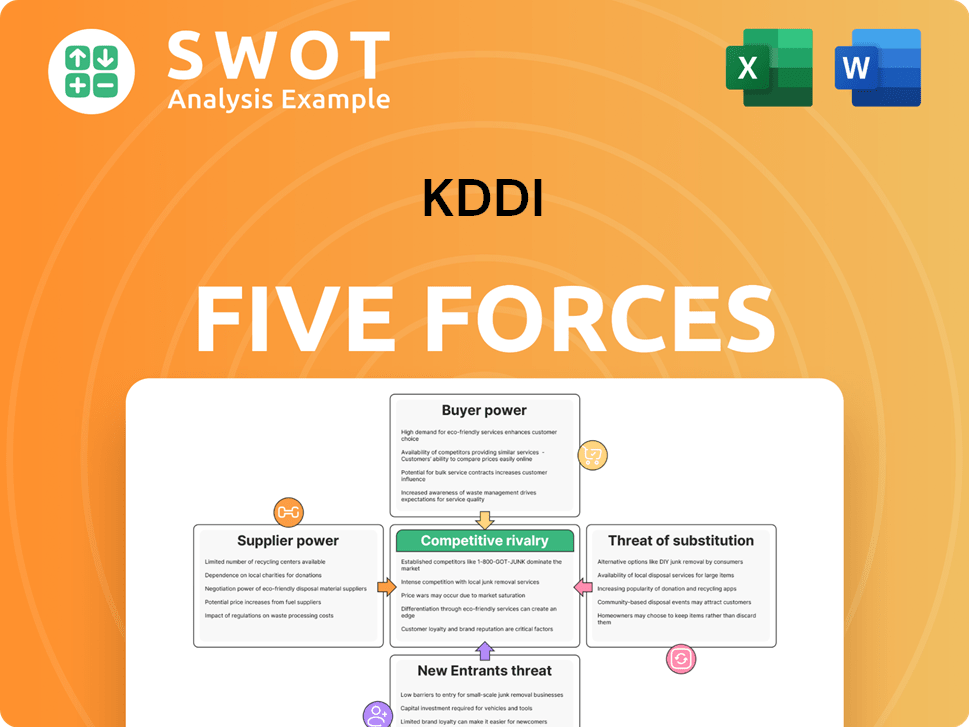KDDI Bundle
Who Really Controls KDDI?
The ownership structure of a company is a window into its strategic heart. KDDI Corporation, a titan in Japanese telecommunications, has a fascinating history. Formed in 2000 through a landmark merger, KDDI has evolved significantly since its inception as Kokusai Denshin Denwa (KDD) in 1953 and DDI Corporation in 1984.

Understanding KDDI SWOT Analysis is key to grasping its competitive landscape. This exploration into KDDI ownership will unravel the story behind who owns KDDI, from its founding to the present day. We'll examine the influence of KDDI shareholders, its KDDI parent company, and the key milestones in KDDI history, offering insights into its governance and future trajectory. As of June 6, 2025, KDDI boasts a market capitalization of approximately $67.59 billion USD, making this analysis particularly relevant for investors and strategists alike, interested in KDDI stock ownership and the KDDI company structure.
Who Founded KDDI?
The ownership structure of KDDI, a major telecommunications company, is rooted in the merger of three entities: DDI Corporation, KDD Corporation, and IDO Corporation. This merger, which occurred in October 2000, formed the present-day KDDI. Understanding the early ownership provides insights into the company's strategic alliances and its evolution within the telecommunications sector.
KDD Corporation, one of the founding entities, was established in 1953 as a state-owned enterprise by the Japanese government. DDI Corporation, another key component, was founded by Kazuo Inamori on June 1, 1984. The merger in 2000 marked a significant consolidation of ownership, bringing these entities together to form KDDI.
While specific equity splits at the inception of each predecessor company aren't readily available in public records, the merger in 2000 was a pivotal moment. It brought together the resources and expertise of the founding companies, setting the stage for KDDI's growth and its position in the market. This consolidation was key to KDDI's future.
Toyota Motor Corporation became a notable early backer of KDDI. This strategic alliance has been crucial for KDDI's development.
Kyocera Corporation has been a major shareholder since the founding of DDI, KDDI's predecessor. This reflects a long-standing business relationship.
Detailed early agreements, such as vesting schedules, are not widely publicized. Strategic alliances shaped the early ownership and direction of KDDI.
The merger of DDI, KDD, and IDO in 2000 was a pivotal event. This consolidation was key to KDDI's future.
Toyota held 12.95% of KDDI's shares as of September 2020. This established a strong strategic alliance.
Toyota and KDDI have collaborated on telematics services since 2002. They also have a global communications platform for connected cars since 2016.
The early ownership of KDDI was significantly shaped by strategic alliances and investments. Toyota's substantial shareholding and long-term collaboration with Kyocera highlight the importance of these partnerships. Understanding the KDDI company structure involves recognizing the roles of these key shareholders and the impact of their strategic alliances on the company's direction and growth. For a deeper dive into the company's business model, you can explore the Revenue Streams & Business Model of KDDI.
- Toyota Motor Corporation: Held 12.95% of shares as of September 2020, indicating a strong strategic alliance.
- Kyocera Corporation: A major shareholder since the inception of DDI, reflecting a long-standing business relationship.
- Strategic Alliances: Collaborations with Toyota on telematics services since 2002 and a global communications platform for connected cars since 2016.
- Merger of Entities: The merger of DDI, KDD, and IDO in October 2000 formed the present-day KDDI.
KDDI SWOT Analysis
- Complete SWOT Breakdown
- Fully Customizable
- Editable in Excel & Word
- Professional Formatting
- Investor-Ready Format

How Has KDDI’s Ownership Changed Over Time?
The ownership structure of the KDDI company has evolved significantly since its establishment in 2000. As a publicly listed entity on the Tokyo Stock Exchange (TYO: 9433), its shares are held by a diverse range of investors. A notable event impacting the ownership structure was the two-for-one stock split, which was effective as of April 1, 2025, increasing the number of issued and outstanding shares to 4,383,692,832.
Another key event was Kyocera Corporation's decision to sell a portion of its KDDI shares to meet future funding demands and strengthen its core businesses, while maintaining a business relationship. This was announced in October 2024 and February 2025. These adjustments, especially in holdings by major corporate investors like Kyocera and Toyota, reflect ongoing strategic realignments and capital management decisions within the KDDI company.
| Major Stakeholder | Percentage of Shares (September 30, 2024) | Percentage of Shares (April 1, 2025) |
|---|---|---|
| KYOCERA Corporation | N/A | 16.61% |
| The Master Trust Bank of Japan, Ltd. (Trust Account) | N/A | 16.35% |
| TOYOTA MOTOR CORPORATION | N/A | 10.08% |
| Custody Bank of Japan, Ltd. (Trust Account) | N/A | 7.52% |
| STATE STREET BANK WEST CLIENT - TREATY 505234 | N/A | 1.73% |
As of April 1, 2025, the breakdown of shareholding by investor type shows that Financial Institutions hold 25.34%, Other Companies hold 27.95%, Securities Firms hold 4.18%, Individuals and Others hold 15.46%, and Foreign Companies, etc., hold 27.07%. For more information, consider reading about the Growth Strategy of KDDI.
KDDI is a publicly traded company, making it accessible for investment through the Tokyo Stock Exchange.
- The major shareholders include KYOCERA Corporation, The Master Trust Bank of Japan, Ltd., and TOYOTA MOTOR CORPORATION.
- The company's ownership structure is dynamic, with adjustments reflecting strategic decisions.
- KDDI's treasury stock holdings, as of April 1, 2025, were 201,681,169 shares.
- The stock split in April 2025 impacted the total number of outstanding shares.
KDDI PESTLE Analysis
- Covers All 6 PESTLE Categories
- No Research Needed – Save Hours of Work
- Built by Experts, Trusted by Consultants
- Instant Download, Ready to Use
- 100% Editable, Fully Customizable

Who Sits on KDDI’s Board?
As of April 1, 2025, Hiromichi Matsuda holds the positions of President, Representative Director, and CEO of the KDDI Corporation. He took over these roles in April 2025, succeeding Makoto Takahashi, who transitioned to the role of Chairman. The Board of Directors includes members representing various interests. While specific affiliations of all board members to major shareholders aren't fully detailed in public summaries, representatives from major corporate shareholders like Kyocera and Toyota are often present on the board or in executive committees, reflecting their significant stakes in the company. Information about the board's composition is regularly updated in the company's annual reports and investor relations materials.
The governance structure of KDDI reflects standard practices for publicly traded companies in Japan. The board's composition and activities are crucial for overseeing the company's strategic direction and ensuring accountability to shareholders. The board's role is to provide oversight and guidance to the management team, ensuring that the company operates in the best interests of its shareholders and stakeholders. The board also plays a key role in risk management, ensuring that the company has appropriate systems and controls in place to mitigate potential risks.
| Board Member | Title | Notes |
|---|---|---|
| Hiromichi Matsuda | President, Representative Director, CEO | Assumed roles in April 2025 |
| Makoto Takahashi | Chairman | Former President and CEO |
| Board Members | Directors | Includes representatives from major shareholders |
KDDI's voting structure follows a one-share-one-vote principle, which is common in Japan. Shareholders exercise their rights at the Ordinary General Meeting of Shareholders, typically held in June. For instance, the 41st Annual Shareholders Meeting was scheduled for June 18, 2025. Shareholders can vote in person, online, or by mail. Cadira Capital Management, an investor, has engaged with KDDI regarding its corporate culture and new leadership, showing optimism for a shift away from more conservative management following President Matsuda's appointment in April 2025. For more details on the company's origins, you can explore the Brief History of KDDI.
KDDI's board includes representatives from major shareholders like Kyocera and Toyota, reflecting their significant stakes. Voting rights are typically exercised at the Ordinary General Meeting of Shareholders in June.
- Hiromichi Matsuda is the current President, Representative Director, and CEO.
- Shareholders can vote in person, online, or by mail.
- The company engages with investors to enhance corporate value.
- Board members' affiliations are often detailed in annual reports.
KDDI Business Model Canvas
- Complete 9-Block Business Model Canvas
- Effortlessly Communicate Your Business Strategy
- Investor-Ready BMC Format
- 100% Editable and Customizable
- Clear and Structured Layout

What Recent Changes Have Shaped KDDI’s Ownership Landscape?
Over the past few years, the ownership structure of the KDDI company has seen significant shifts, reflecting broader trends in the telecommunications industry. In May 2025, the company announced a substantial share repurchase program, planning to buy back up to 196,000,000 shares, which is about 4.92% of the total issued shares (excluding treasury stock). The budget for this share buyback is up to 400 billion yen, with the program running from May 15, 2025, to December 23, 2025. This move followed earlier repurchases, such as the 8,462,700 shares bought back between January 1, 2025, and January 31, 2025, totaling 41,044,038,900 yen. These actions are aimed at boosting shareholder value and optimizing the company's capital structure.
These share repurchases are part of a larger strategy that also includes mergers and acquisitions. In January 2025, KDDI completed a tender offer to acquire LAC Co., Ltd., making it a wholly-owned subsidiary. This strategic move is designed to integrate management resources and strengthen cybersecurity services within the KDDI Group, particularly as AI becomes more prevalent. Furthermore, the company has been diversifying into non-telecom businesses. A notable example is the joint management structure with Mitsubishi Corporation for Lawson, a convenience store chain, with each holding a 50% stake. This diversification is a key element of KDDI's growth strategy, as highlighted by incoming CEO Hiromichi Matsuda in March 2025.
| Ownership Trend | Details | Impact |
|---|---|---|
| Share Repurchases | Up to 196,000,000 shares repurchased in 2025. | Enhances shareholder value. |
| Strategic Acquisitions | Acquisition of LAC Co., Ltd. in January 2025. | Strengthens cybersecurity services. |
| Diversification | Joint management of Lawson with Mitsubishi Corporation. | Expands into non-telecom businesses. |
Leadership changes also play a role in the company’s evolution. Hiromichi Matsuda took over as President, Representative Director, and CEO on April 1, 2025, replacing Makoto Takahashi, who moved to the role of Chairman. This leadership transition underscores a focus on 'total engagement' and a shift towards more proactive management. The evolving ownership landscape also includes shifts in shareholder composition, with increased institutional ownership and strategic divestments by long-term corporate shareholders. For more insights, you can read about the Growth Strategy of KDDI.
KDDI's ownership profile has been actively managed, with buyback programs and strategic acquisitions. These actions are geared towards enhancing shareholder value and adapting to market changes. The company's moves reflect a proactive approach to capital management and strategic growth.
The shareholder base includes significant holdings by foreign companies and financial institutions. Strategic divestments by long-term shareholders also shape the ownership structure. These shifts reflect evolving market dynamics and strategic realignments.
KDDI is focusing on digital social infrastructure driven by data and generative AI. The company aims to create a society where everyone can realize their dreams. This vision guides its strategic initiatives and future investments.
Hiromichi Matsuda became CEO on April 1, 2025, emphasizing a focus on proactive management. This leadership change supports the company's strategic goals and future growth plans. The transition signals a commitment to innovation and adaptability.
KDDI Porter's Five Forces Analysis
- Covers All 5 Competitive Forces in Detail
- Structured for Consultants, Students, and Founders
- 100% Editable in Microsoft Word & Excel
- Instant Digital Download – Use Immediately
- Compatible with Mac & PC – Fully Unlocked

Related Blogs
- What are Mission Vision & Core Values of KDDI Company?
- What is Competitive Landscape of KDDI Company?
- What is Growth Strategy and Future Prospects of KDDI Company?
- How Does KDDI Company Work?
- What is Sales and Marketing Strategy of KDDI Company?
- What is Brief History of KDDI Company?
- What is Customer Demographics and Target Market of KDDI Company?
Disclaimer
All information, articles, and product details provided on this website are for general informational and educational purposes only. We do not claim any ownership over, nor do we intend to infringe upon, any trademarks, copyrights, logos, brand names, or other intellectual property mentioned or depicted on this site. Such intellectual property remains the property of its respective owners, and any references here are made solely for identification or informational purposes, without implying any affiliation, endorsement, or partnership.
We make no representations or warranties, express or implied, regarding the accuracy, completeness, or suitability of any content or products presented. Nothing on this website should be construed as legal, tax, investment, financial, medical, or other professional advice. In addition, no part of this site—including articles or product references—constitutes a solicitation, recommendation, endorsement, advertisement, or offer to buy or sell any securities, franchises, or other financial instruments, particularly in jurisdictions where such activity would be unlawful.
All content is of a general nature and may not address the specific circumstances of any individual or entity. It is not a substitute for professional advice or services. Any actions you take based on the information provided here are strictly at your own risk. You accept full responsibility for any decisions or outcomes arising from your use of this website and agree to release us from any liability in connection with your use of, or reliance upon, the content or products found herein.